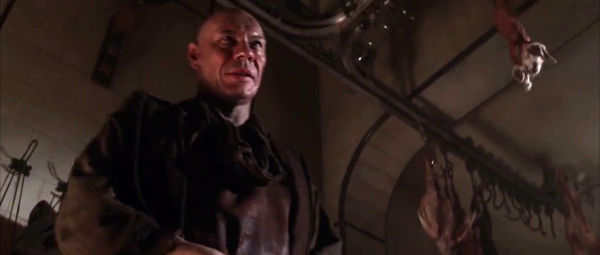I'm about 30 minutes into describing the film now.
I have a day job, and audio description is highly asymmetric to run-time. It takes approximately 2 hours to describe 20 minutes of film. Alien
3 is quite a lot of 20 minutes. Anyway, I thought I'd talk about naming characters, because it's a
thing.
So, what do we call this guy?

Audio Description is an attempt to give a blind or low-vision person the same information as a sighted person, and part of that is to not give them
more information than a sighted person.
So, in the description if I was to refer to the character as "Clemens", then that's problematic as even a sighted person wouldn't know that. At most, they'd say "Hey, it's that guy who was in, you know, that thing ... you remember ..."
There's a prevailing school of thought in audio description that you do not refer to a character by name,
until they have been named in the production.
So, without a name, they are usually given a sort of visual placeholder nickname. Like "the brunette" or "the bearded man".
There are two side-effects to this.
The first is that the nickname, say "The woman with the eye-patch" usually takes up more syllables than the actual name, let's call her "Jane". It necessarily cuts into remaining space for other description. We strive for economy, for brevity, and this largely runs counter to that.
The second is that it can lead to situations where — as in at least one AD for ALIEN — the narrator is referring to Dallas, Lambert and "The dark haired man" exploring the derelict, because
it takes that long for someone to call Kane by his name. Which is really just ridiculous. Some people cling rigidly to rules, instead of looking at the situation and adapting their approach.
In the theatrical cut of ALIENS, no-one mentions Ripley's name until the Board-Room Debriefing; until then in the audio description track on Crave, she's "The wavy haired woman."
My own approach in my version of ALIENS was to refer to Ripley by name without waiting, because it's a sequel, and there's no mystery to preserve for her character. The names of all the marines were referred to on a computer screen, so I felt confident naming them as they were introduced, rather than when their names were used incidentally.
In Alien
3 I'm going to refer to Ripley, Newt, Hicks and Bishop without introduction.
But I'll follow the industry standard and use placeholders until the characters are named.
Of course, one problem with describing Alien
3 is that it's largely populated wth characters who are functionally bald guys, mostly white bald guys, wearing pretty much the same kind of clothes. Not so much to distinguish them.
So, let's look at when we can start using people's names.
- Ripley (in writing) at 07:27.
- Andrews (in writing) at 08:35.
- Frank at 08:44 (but he's just one bald guy among many)
- Dillon at 09:38 (straight away, thank heavens!)
- Clemens at 13:00
- Ripley (in dialogue) at 14:49
- Murphy is introduced as "murph" at 24:51.
- Frank is named again at 25:19, it's much easier to identify him.
- Golic at 32:12 (two so-far nameless prisoners are complaining about him)
- Mr Aaron, 34:06.
(So if you ever write a movie script, you can do the audio describers a favour by naming every important character as soon as possible, even if it's just a flash of a security badge or an offhand comment. It would have been great if one of the prisoners who look dumbly at Clemens when he carried in Ripley said "Hey Clemens!"
So what am I going to call Clemens?
So far I've gone with "The blue-eyed man", because there are several shots where his piercing blue eyes are quite apparent; but I'm not happy with it, and I may change it later.
Other DetailsOne thing I love about audio description is that because of the stop-starting and continual replaying, you pick up some background details.
I have no idea if anyone has done a fine tooth-comb through Alien
3 but I noticed these:

(Above) Enhanced screenshot. It's always fun to see brand-names in the future. Looks like investing in
Rocket Medical PLC is a good long term investment.

(Above) If you scrutinse the abattoir, you can get some insight into the diet of the prisoners. In this screen-shot, top-right, there is a rabbit hanging still with the fur on its head and paws, and what appears to be a meat bird further in the background bottom-right. There's definitely somewhere they're keeping animals for eating.
It's been a long time since I've seen the film (and only Theatrical at that) so I don't know if a sort of farmyard area is ever shown, but I guess they also keep the oxen somewhere.